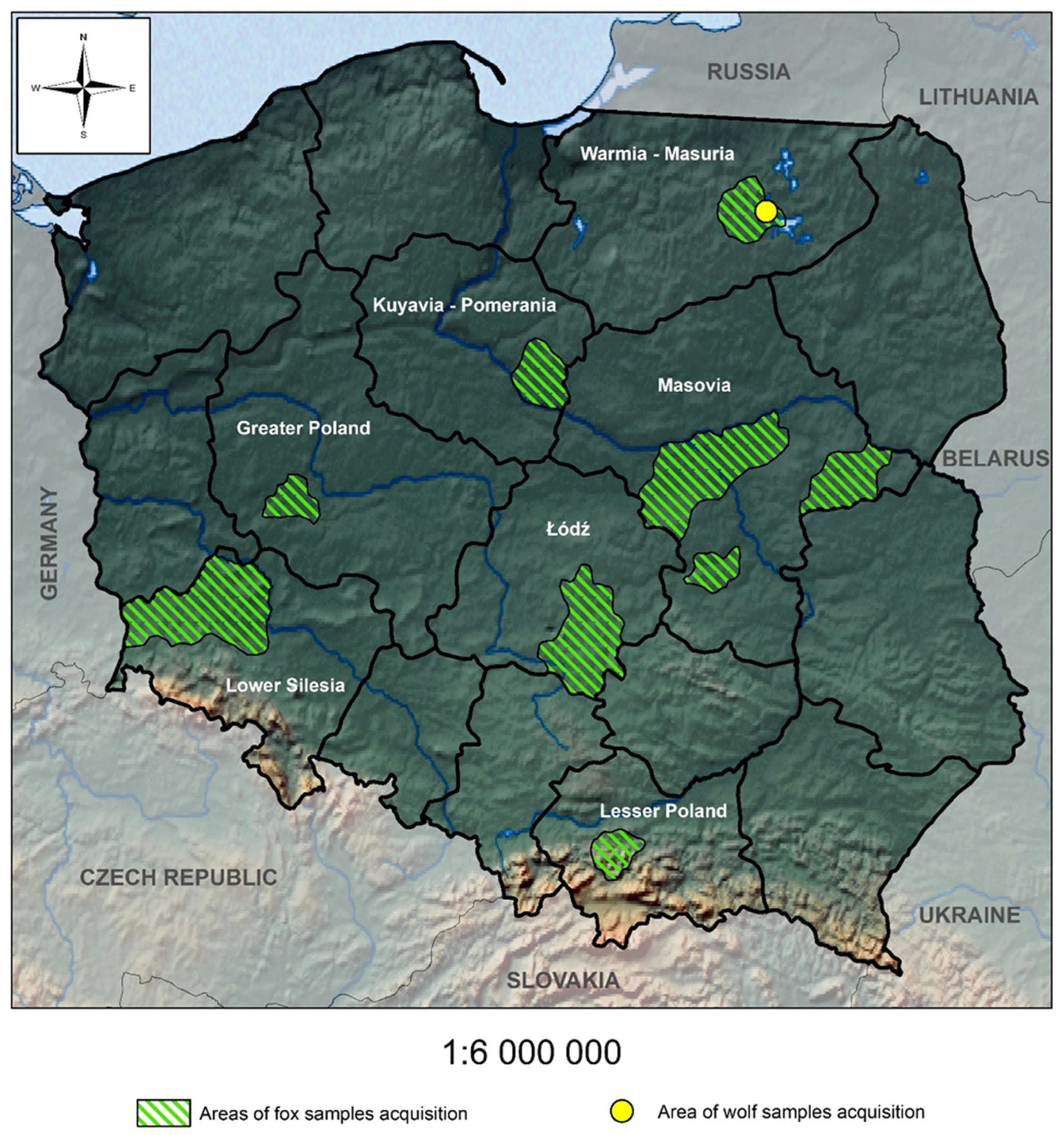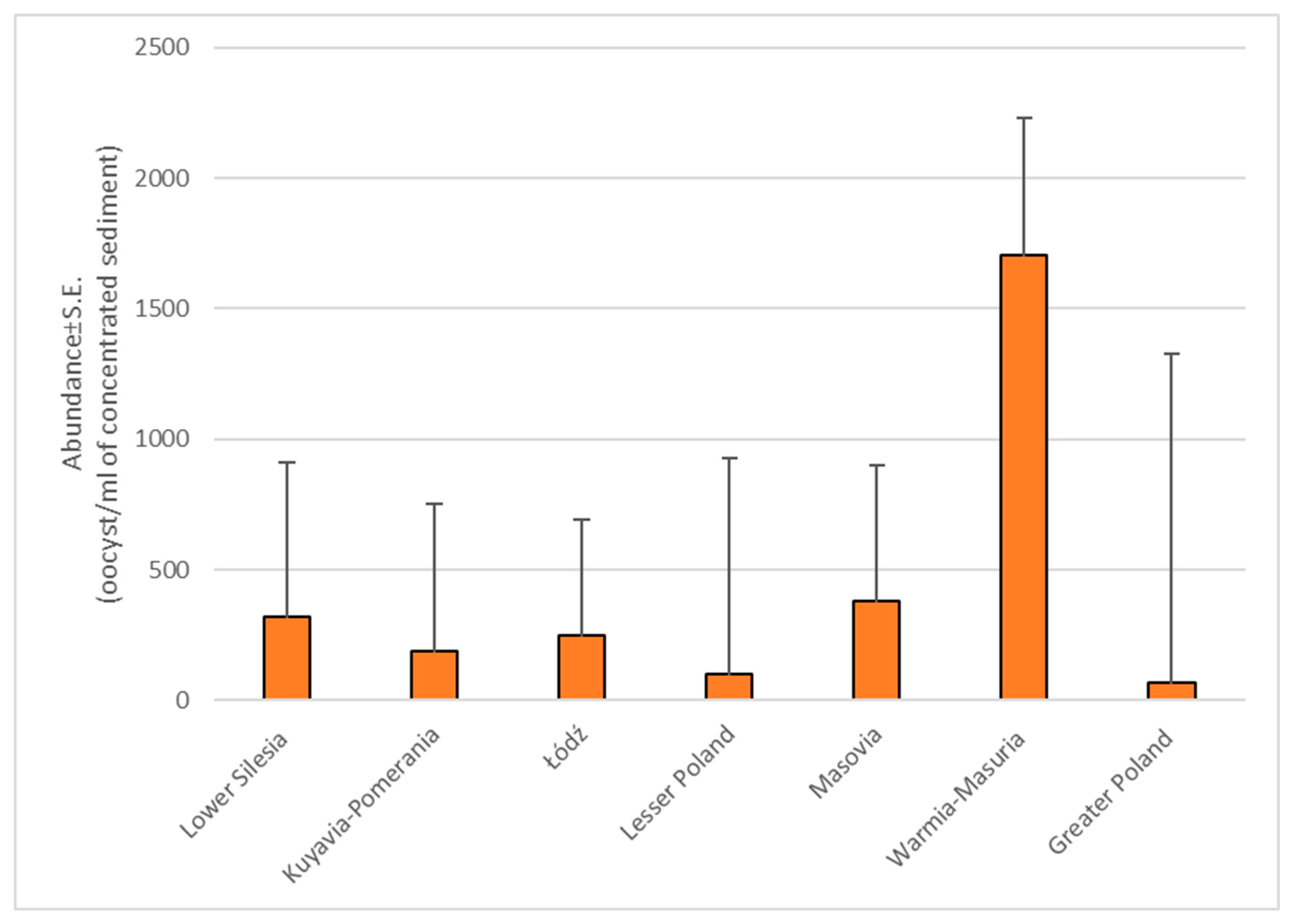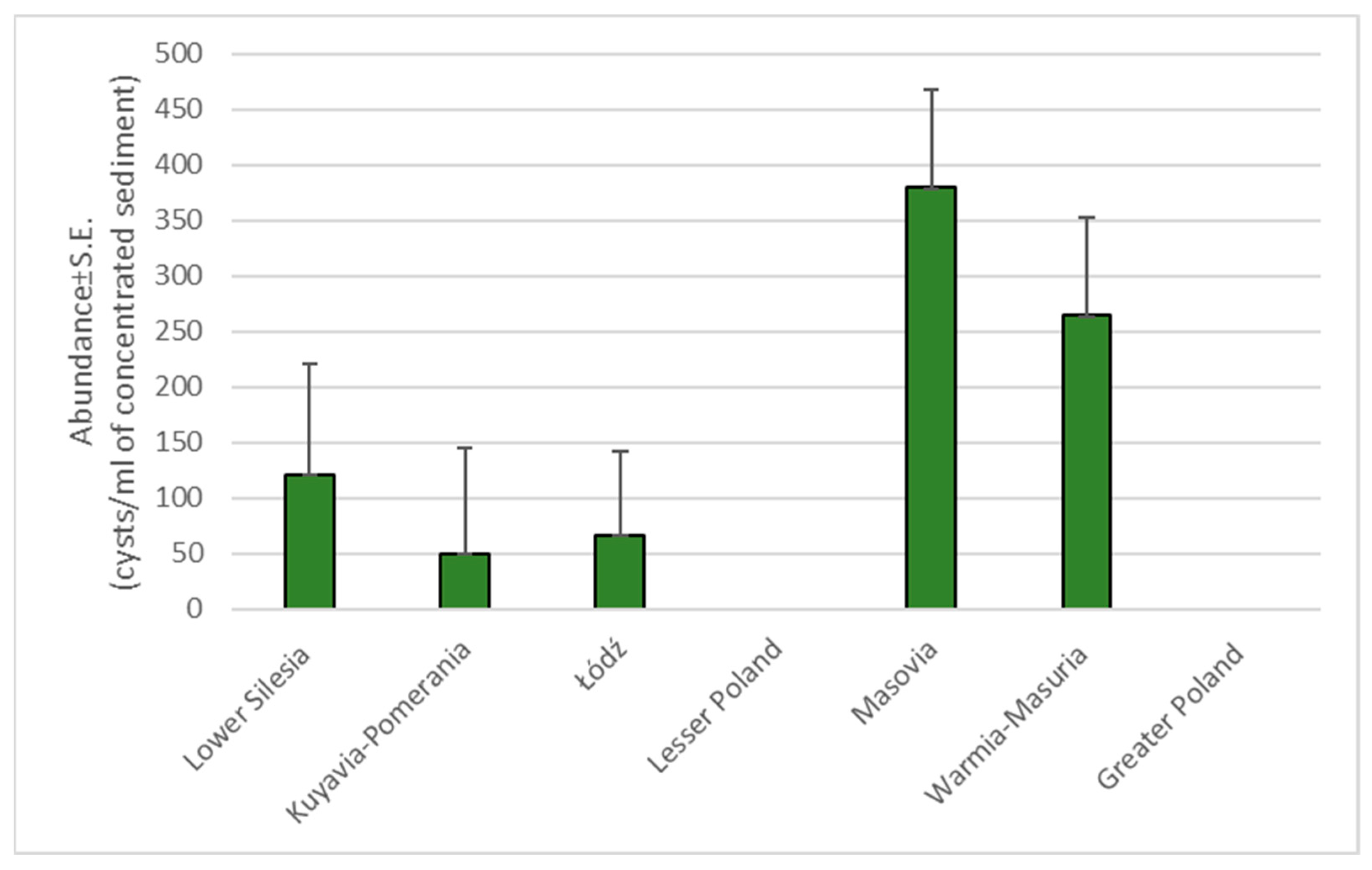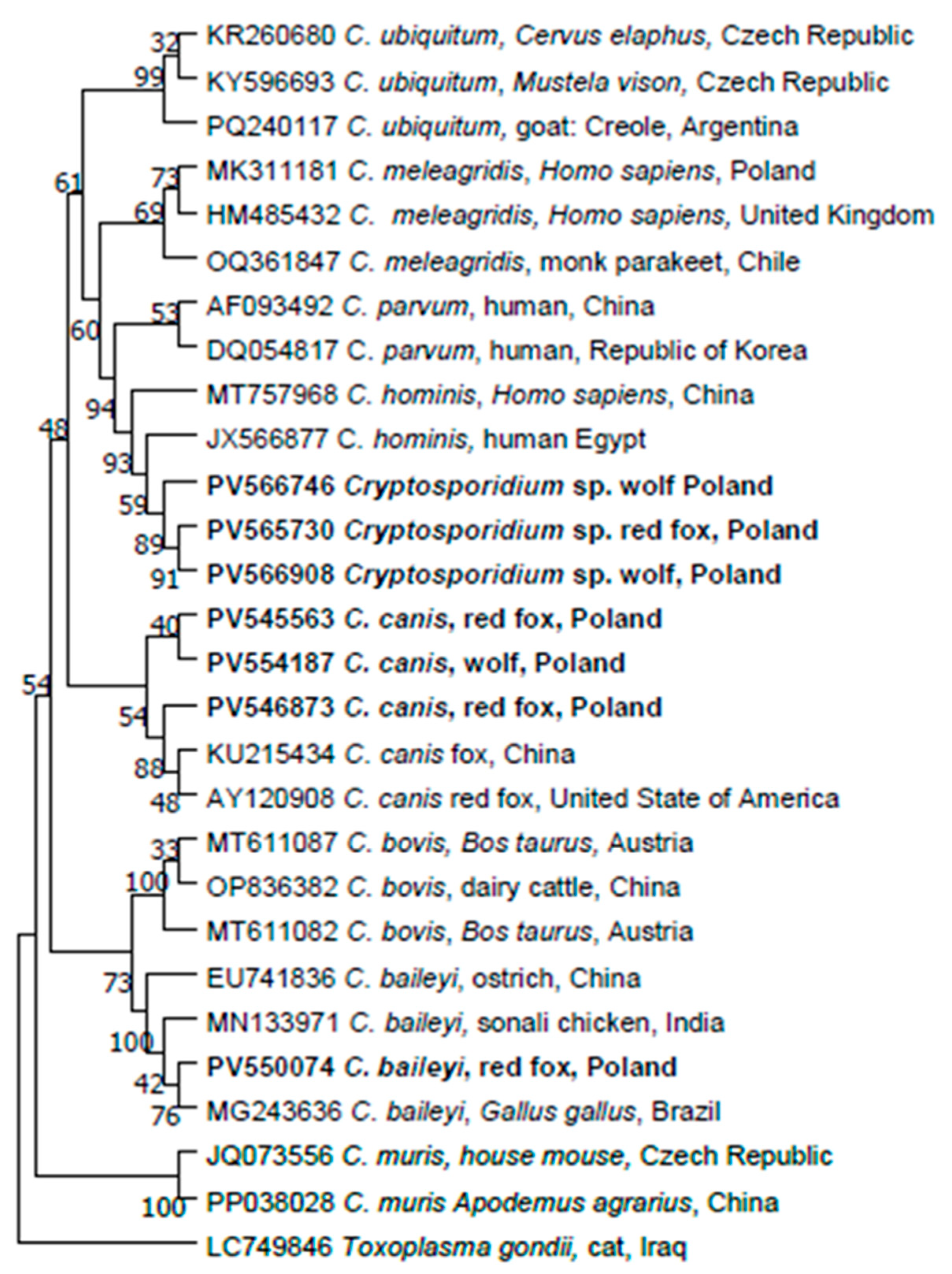Red Fox (Vulpes vulpes) and Wolf (Canis lupus) as a Reservoir of Cryptosporidium spp. and Giardia intestinalis in Poland
Abstract
1. Introduction
2. Materials and Methods
2.1. Collection of Faecal Samples from Foxes
2.2. Collection of Faecal Samples from Wolves
2.3. The Modified Ziehl–Neelsen Staining of Faecal Smears
2.4. Immunofluorescence Assay (IFA) MeriFluor Cryptosporidium/Giardia
2.5. Molecular Methods
2.6. Phylogenetic Analysis
2.7. Statistical Analysis
3. Results
3.1. Foxes
3.1.1. Cryptosporidium spp.
3.1.2. Giardia intestinalis
3.2. Wolves
3.3. Comparison of the Prevalence of Cryptosporidium/Giardia Infection Between Red Fox and Wolf
3.4. Phylogenetic Analysis and Molecular Identification of Cryptosporidium spp.
3.4.1. Foxes
3.4.2. Wolves
3.5. Comparison of Abundance Between Cryptosporidium Species in Red Fox Population
4. Discussion
5. Conclusions
Author Contributions
Funding
Institutional Review Board Statement
Informed Consent Statement
Data Availability Statement
Acknowledgments
Conflicts of Interest
References
- Rojas, A.; Germitsch, N.; Oren, S.; Sazmand, A.; Deak, G. Wildlife parasitology: Sample collection and processing, diagnostic constraints, and methodological challenges in terrestrial carnivores. Parasit. Vectors 2024, 17, 127. [Google Scholar] [CrossRef] [PubMed]
- Wegner, G.I.; Murray, K.A.; Springmann, M.; Muller, A.; Sokolow, S.H.; Saylors, K.; Morens, D.M. Averting wildlife-borne infectious disease epidemics requires a focus on socio-ecological drivers and a redesign of the global food system. EClinicalMedicine 2022, 47, 101386. [Google Scholar] [CrossRef]
- Fagre, A.C.; Cohen, L.E.; Eskew, E.A.; Farrell, M.; Glennon, E.; Joseph, M.B.; Frank, H.K.; Ryan, S.J.; Carlson, C.J.; Albery, G.F. Assessing the risk of human-to-wildlife pathogen transmission for conservation and public health. Ecol. Lett. 2022, 25, 1534–1549. [Google Scholar] [CrossRef]
- Karamon, J.; Sroka, J.; Dąbrowska, J.; Bilska-Zając, E.; Skrzypek, K.; Różycki, M.; Zdybel, J.; Cencek, T. Distribution of parasitic helminths in the small intestine of the red fox (Vulpes vulpes). Pathogens 2020, 9, 477. [Google Scholar] [CrossRef] [PubMed]
- Dwużnik, D.; Mierzejewska, E.J.; Kowalec, M.; Alsarraf, M.; Stańczak, Ł.; Opalińska, P.; Krokowska-Paluszak, M.; Górecki, G.; Bajer, A. Ectoparasites of red foxes (Vulpes vulpes) with a particular focus on ticks in subcutaneous tissues. Parasitology 2020, 147, 1359–1368. [Google Scholar] [CrossRef] [PubMed]
- Lesiczka, P.M.; Rudenko, N.; Golovchenko, M.; Juránková, J.; Daněk, O.; Modrý, D.; Hrazdilová, K. Red fox (Vulpes vulpes) play an important role in the propagation of tick-borne pathogens. Ticks Tick Borne Dis. 2023, 14, 102076. [Google Scholar] [CrossRef]
- Mierzejewska, E.J.; Dwużnik, D.; Koczwarska, J.; Stańczak, Ł.; Opalińska, P.; Krokowska-Paluszak, M.; Wierzbicka, A.; Górecki, G.; Bajer, A. The red fox (Vulpes vulpes), a possible reservoir of Babesia vulpes, B. canis and Hepatozoon canis and its association with the tick Dermacentor reticulatus occurrence. Ticks Tick Borne Dis. 2021, 12, 101551. [Google Scholar] [CrossRef]
- Bagrade, G.; Deksne, G.; Ozoliņa, Z.; Howlett, S.J.; Interisano, M.; Casulli, A.; Pozio, E. Echinococcus multilocularis in foxes and raccoon dogs: An increasing concern for Baltic countries. Parasit. Vectors 2016, 9, 615. [Google Scholar] [CrossRef]
- Gawor, J.; Laskowski, Z.; Myczka, A.W.; Zwijacz-Kozica, T.; Sałamatin, R. Occurrence of Echinococcus spp. in red foxes and wolves in the protected area of the Tatra National Park in southern Poland—A threat to human health. Ann. Agric. Environ. Med. 2021, 28, 579–584. [Google Scholar] [CrossRef]
- Panek, M.; Budny, M. Sytuacja Zwierząt Łownych w Polsce-Wyniki Monitoringu 2023; Stacja Badawcza Czempiń: Czempiń, Poland, 2023. [Google Scholar]
- Nowak, S.; Szewczyk, M.; Stępniak, K.M.; Kwiatkowska, I.; Kurek, K.; Mysłajek, R.W. Wolves in the borderland—Changes in population and wolf diet in Romincka Forest along the Polish–Russian–Lithuanian state borders. Wildl. Biol. 2024, 2024, e01210. [Google Scholar] [CrossRef]
- Vorel, A.; Kadlec, I.; Toulec, T.; Selimovic, A.; Horníček, J.; Vojtěch, O.; Mokrý, J.; Pavlačík, L.; Arnold, W.; Cornils, J.; et al. Home range and habitat selection of wolves recolonising central European human-dominated landscapes. Wildl. Biol. 2024, 2024, e01245. [Google Scholar] [CrossRef]
- Nowak, S.; Mysłajek, R.W.; Kłosińska, A.; Gabryś, G. Diet and prey selection of wolves (Canis lupus) recolonising Western and Central Poland. Mamm. Biol. 2011, 76, 709–715. [Google Scholar] [CrossRef]
- Jędrzejewski, W. Prey choice and diet of wolves related to ungulate communities and wolf subpopulations in Poland. J. Mammal. 2012, 93, 1480–1492. [Google Scholar] [CrossRef]
- Mysłajek, R.W.; Stachyra, P.; Figura, M.; Nędzyńska-Stygar, M.; Stefański, R.; Korga, M.; Kwiatkowska, I.; Stępniak, K.M.; Tołkacz, K.; Nowak, S. Diet of the grey wolf Canis lupus in Roztocze and Solska Forest, south-east Poland. J. Vertebr. Biol. 2022, 7, 11–12. [Google Scholar] [CrossRef]
- Mysłajek, R.W.; Tracz, M.; Tracz, M.; Tomczak, P.; Szewczyk, M.; Niedźwiecka, N.; Nowak, S. Spatial organization in wolves Canis lupus recolonizing north-west Poland: Large territories at low population density. Mammal. Biol. 2018, 92, 37–44. [Google Scholar] [CrossRef]
- Meyer, C.J.; Cassidy, K.A.; Stahler, E.E.; Brandell, E.E.; Anton, C.B.; Stahler, D.R.; Smith, D.W. Parasitic infection increases risk-taking in a social, intermediate host carnivore. Commun. Biol. 2022, 5, 1180. [Google Scholar] [CrossRef]
- Tołkacz, K.; Kretschmer, M.; Nowak, S.; Mysłajek, R.W.; Alsarraf, M.; Wężyk, D.; Bajer, A. The first report on Hepatozoon canis in dogs and wolves in Poland: Clinical and epidemiological features. Parasit. Vectors 2023, 16, 313. [Google Scholar] [CrossRef]
- Wymazał, A.; Nowak, S.; Mysłajek, R.W.; Bajer, A.; Welc-Falęciak, R.; Szewczyk, M.; Kwiatkowska, I.; Stępniak, K.M.; Figura, M.; Kloch, A. Tick-borne infections in wolves from an expanding population in Eastern Europe. Ticks Tick-Borne Dis. 2024, 15, 102272. [Google Scholar] [CrossRef]
- Papini, R.A.; Verin, R. Giardia and Cryptosporidium in red foxes (Vulpes vulpes): Screening for coproantigens in a population of Central Italy and mini-review of the literature. Maced. Vet. Rev. 2019, 42, 101–106. [Google Scholar] [CrossRef]
- Hamnes, I.S.; Gjerde, B.K.; Forberg, T.; Robertson, L.J. Occurrence of Giardia and Cryptosporidium in Norwegian red foxes (Vulpes vulpes). Vet. Parasitol. 2007, 143, 347–353. [Google Scholar] [CrossRef]
- Mateo, M.; de Mingo, M.H.; de Lucio, A.; Morales, L.; Balseiro, A.; Espí, A.; Barral, M.; Lima Barbero, J.F.; Habela, M.Á.; Fernández-García, J.L.; et al. Occurrence and molecular genotyping of Giardia duodenalis and Cryptosporidium spp. in wild mesocarnivores in Spain. Vet. Parasitol. 2017, 235, 86–93. [Google Scholar] [CrossRef] [PubMed]
- Ravaszova, P.; Halanova, M.; Goldova, M.; Valencakova, A.; Malcekova, B.; Hurníková, Z.; Halan, M. Occurrence of Cryptosporidium spp. in red foxes and brown bear in the Slovak Republic. Parasitol. Res. 2012, 110, 469–471. [Google Scholar] [CrossRef]
- Perec-Matysiak, A.; Hildebrand, J.; Popiołek, M.; Buńkowska-Gawlik, K. The occurrence of Cryptosporidium spp. in wild-living carnivores in Poland—A question concerning its host specificity. Pathogens 2023, 12, 198. [Google Scholar] [CrossRef] [PubMed]
- Paziewska, A.; Bednarska, M.; Niewegłowski, H.; Karbowiak, G.; Bajer, A. Distribution of Cryptosporidium and Giardia spp. in selected species of protected and game mammals from North-Eastern Poland. Ann. Agric. Environ. Med. 2007, 14, 265–270. [Google Scholar]
- Hermosilla, C.; Kleinertz, S.; Silva, L.M.; Hirzmann, J.; Huber, D.; Kusak, J.; Taubert, A. Protozoan and helminth parasite fauna of free-living Croatian wild wolves (Canis lupus) analyzed by scat collection. Vet. Parasitol. 2017, 233, 14–19. [Google Scholar] [CrossRef]
- Sulżyc-Bielicka, V.; Kołodziejczyk, L.; Jaczewska, S.; Bielicki, D.; Kładny, J.; Safranow, K. Prevalence of Cryptosporidium sp. in patients with colorectal cancer. Pol. Przegl. Chir 2012, 84, 348–351. [Google Scholar] [CrossRef]
- Bednarska, M.; Jankowska, I.; Pawelas, A.; Piwczyńska, K.; Bajer, A.; Wolska-Kuśnierz, B.; Wielopolska, M.; Welc-Falęciak, R. Prevalence of Cryptosporidium, Blastocystis, and other opportunistic infections in patients with primary and acquired immunodeficiency. Parasitol. Res. 2018, 117, 2869–2879. [Google Scholar] [CrossRef]
- Wang, R.J.; Li, J.Q.; Chen, Y.C.; Zhang, L.X.; Xiao, L.H. Widespread occurrence of Cryptosporidium infections in patients with HIV/AIDS: Epidemiology, clinical feature, diagnosis, and therapy. Acta Trop. 2018, 187, 257–263. [Google Scholar] [CrossRef]
- Mahdavi, F.; Sadrebazzaz, A.; Chahardehi, A.M.; Badali, R.; Omidian, M.; Hassanipour, S.; Asghari, A. Global epidemiology of Giardia duodenalis infection in cancer patients: A systematic review and meta-analysis. Int. Health 2022, 14, 5–17. [Google Scholar] [CrossRef] [PubMed]
- Oyeyemi, O.T.; Oyeyemi, I.T.; Alamukii, N.A.; Kone, J.K.; Oyerinde, O.R.; Anuoluwa, I.A.; Tiamiyu, A.M. Cryptosporidium and colorectal cancer: A review of epidemiology and possible association. Forum Clin. Oncol. Sciendo 2021, 12, 61–71. [Google Scholar] [CrossRef]
- Adler, S.; Widerstrom, M.; Lindh, J.; Lilja, M. Symptoms and risk factors of Cryptosporidium hominis infection in children: Data from a large waterborne outbreak in Sweden. Parasitol. Res. 2017, 116, 2613–2618. [Google Scholar] [CrossRef] [PubMed]
- Bouzid, M.; Kintz, E.; Hunter, P.R. Risk factors for Cryptosporidium infection in low and middle income countries: A systematic review and meta-analysis. PLoS Negl. Trop. Dis. 2018, 12, e0006553. [Google Scholar] [CrossRef]
- Menu, E.; Mosnier, E.; Cotrel, A.; Favennec, L.; Razakandrainibe, R.; Valot, S.; Blanchet, D.; Dalle, F.; Costa, D.; Gaillet, M.; et al. Cryptosporidiosis outbreak in Amazonia, French Guiana, 2018. PLoS Negl. Trop. Dis. 2022, 16, e0010068. [Google Scholar] [CrossRef]
- Costa, D.; Razakandrainibe, R.; Basmaciyan, L.; Raibaut, J.; Delaunay, P.; Morio, F.; Gargala, G.; Villier, V.; Mouhajir, A.; Levy, B.; et al. A summary of cryptosporidiosis outbreaks reported in France and overseas departments, 2017–2020. Food Waterborne Parasitol. 2020, 27, e00160. [Google Scholar] [CrossRef] [PubMed]
- Khattak, I.; Yen, W.L.; Usman, T.; Nasreen, N.; Khan, A.; Ahmad, S.; Rehman, G.; Khan, K.; Said, M.B.; Chen, C.C. Individual and community-level risk Factors for giardiasis in children under five years of age in Pakistan: A prospective multi-regional study. Children 2023, 10, 1087. [Google Scholar] [CrossRef]
- Bajer, A. Cryptosporidium and Giardia spp. infections in humans, animals and the environment in Poland. Parasitol. Res. 2008, 104, 1–17. [Google Scholar] [CrossRef]
- Chalmers, R.; Davies, A. Minireview: Clinical cryptosporidiosis. Exp. Parasitol. 2010, 124, 138–146. [Google Scholar] [CrossRef]
- Zahedi, A.; Ryan, U. Cryptosporidium—An update with an emphasis on foodborne and waterborne transmission. Res. Vet. Sci. 2020, 132, 500–512. [Google Scholar] [CrossRef]
- Gatei, W.; Wamae, C.N.; Mbae, C.; Waruru, A.; Mulinge, E.; Waithera, T.; Gatika, S.M.; Kamwati, S.K.; Revathi, G.; Hart, C.A. Cryptosporidiosis: Prevalence, genotype analysis, and symptoms associated with infections in children in Kenya. Am. J. Trop. Med. Hyg. 2006, 75, 78–82. [Google Scholar] [CrossRef]
- Piekara-Stępińska, A.; Gorczykowski, M.; Piekarska, J.; Doch, A.; Kuchczyńska, A.; Szczepańska, K.; Nowańska, K.; Krajewska, M. Kryptosporydioza kotów jako problem zoonotyczny—Przypadek kliniczny. In Proceedings of the VIII Konferencja Niebezpieczne Zoonozy: Toksokaroza, Toksoplazmoza, Echinokokoza, WIHE, Warsaw, Poland, 17–20 October 2018. (In Polish). [Google Scholar]
- Elhadad, H.; Abdo, S.; Tolba, M.; Salem, A.I.; Mohamed, M.A.; El-Abd, E.A.; El-Taweel, H.A. Detection of Giardia intestinalis assemblages A and B among children from three villages in the West Delta region, Egypt using assemblage specific primers. J. Parasit. Dis. 2021, 45, 655–663. [Google Scholar] [CrossRef] [PubMed]
- Vicente, B.; Freitas, A.; Freitas, M.; Midlej, V. Systematic review of diagnostic approaches for human giardiasis: Unveiling optimal strategies. Diagnostics 2024, 4, 364. [Google Scholar] [CrossRef] [PubMed]
- Abdelsalam, I.M.; Sarhan, R.M.; Hanafy, M.A. The impact of different copro-preservation conditions on molecular detection of Cryptosporidium species. Iran. J. Parasitol. 2017, 12, 274–283. [Google Scholar] [PubMed]
- Henriksen, S.A.; Pohlenz, J.F. Staining of cryptosporidia by a modified Ziehl-Neelsen technique. Acta Vet. Scand. 1981, 22, 594–596. [Google Scholar] [CrossRef]
- Garcia, L.S.; Bruckner, D.A. Diagnostic Medical Parasitology; Elsevier Science Publishing: London, UK, 1988. [Google Scholar]
- Silva, S.O.; Richtzenhain, L.J.; Barros, I.N.; Gomes, A.M.; Silva, A.V.; Kozerski, N.D.; de Araújo Ceranto, J.B.; Keid, L.B.; Soares, R.M. A new set of primers directed to 18S rRNA gene for molecular identification of Cryptosporidium spp. and their performance in the detection and differentiation of oocysts shed by synanthropic rodents. Exp. Parasitol. 2013, 135, 551–557. [Google Scholar] [CrossRef]
- Faridi, A.; Tavakoli Kareshk, A.; Sadooghian, S.; Firouzeh, N. Frequency of different genotypes of Giardia duodenalis in slaughtered sheep and goat in east of Iran. J. Parasit. Dis. 2020, 44, 618–624. [Google Scholar] [CrossRef] [PubMed]
- Tamura, K.; Stecher, G.; and Kumar, S. MEGA 11: Molecular Evolutionary Genetics Analysis Version 11. Mol. Biol. Evol. 2021, 38, 3022–3027. [Google Scholar] [CrossRef]
- Hodžić, A.; Alić, A.; Omeragić, J. Occurrence of Cryptosporidium spp. and Giardia duodenalis in red foxes (Vulpes vulpes) in Bosnia and Herzegovina. Maced. Vet. Rev. 2014, 37, 189–192. [Google Scholar] [CrossRef]
- Barrera, J.P.; Carmena, D.; Rodríguez, E.; Checa, R.; López, A.M.; Fidalgo, L.E.; Gálvez, R.; Marino, V.; Fuentes, I.; Miró, G.; et al. The red fox (Vulpes vulpes) as a potential natural reservoir of human cryptosporidiosis by Cryptosporidium hominis in Northwest Spain. Transbound. Emerg. Dis. 2020, 67, 2172–2182. [Google Scholar] [CrossRef]
- Mateusa, M.; Cīrulis, A.; Selezņova, M.; Šveisberga, D.P.; Terentjeva, M.; Deksne, G. Cryptosporidium spp. are associated with Giardia duodenalis co-infection in wild and domestic canids. Animals 2024, 14, 3484. [Google Scholar] [CrossRef]
- Kvac, M.; Myskova, E.; Holubova, N.; Kellnerova, K.; Kicia, M.; Rajsky, D.; McEvoy, J.; Feng, Y.; Hanzal, V.; Sak, B. Occurrence and genetic diversity of Cryptosporidium spp. in wild foxes, wolves, jackals, and bears in central Europe. Fol. Parasitol. 2021, 68, 002. [Google Scholar] [CrossRef]
- Bajer, A. Prevalence and abundance of Cryptosporidium parvum and Giardia spp. in wild rural rodents from the Mazury Lake District region of Poland. Parasitology 2002, 125, 21–34. [Google Scholar] [CrossRef] [PubMed]
- Sroka, J.; Giżejewski, Z.; Wójcik-Fatla, A.; Stojecki, K.; Bilska-Zając, E.; Dutkiewicz, J.; Cencek, T.; Karamon, J.; Zając, V.; Kusyk, P.; et al. Potential role of beavers (Castor fiber) in contamination of water in the Masurian Lake District (north-eastern Poland) with protozoan parasites Cryptosporidium spp. and Giardia duodenalis. J. Vet. Res. 2015, 59, 219–228. [Google Scholar] [CrossRef]
- Rzeżutka, A.; Kaupke, A. Cryptosporidium infections in asymptomatic calves up to 4 months in Poland: A cross-sectional population study. Sci. Rep. 2023, 13, 20997. [Google Scholar] [CrossRef] [PubMed]
- Murnik, L.C.; Daugschies, A.; Delling, C. Cryptosporidium infection in young dogs from Germany. Parasitol. Res. 2022, 121, 2985–2993. [Google Scholar] [CrossRef]
- Ortega, S.; Figueiredo, A.M.; Moroni, B.; Abarca, N.; Dashti, A.; Köster, P.C.; Bailo, B.; Cano-Terriza, D.; Gonzálvez, M.; Fayos, M.; et al. Free-ranging wolves (Canis lupus) are natural reservoirs of intestinal microeukaryotes of public health significance in Southwestern Europe. Zoonoses Public Health 2024, 121, 2985–2993. [Google Scholar] [CrossRef]
- Figueiredo, A.M.; Köster, P.C.; Dashti, A.; Torres, R.T.; Fonseca, C.; Mysterud, A.; Bailo, B.; Carvalho, J.; Ferreira, E.; Hipólito, D.; et al. Molecular detection and distribution of Giardia duodenalis and Cryptosporidium spp. infections in wild and domestic animals in Portugal. Transbound. Emerg. Dis. 2023, 2023, 5849842. [Google Scholar] [CrossRef]
- Kloch, A.; Bednarska, M.; Bajer, A. Intestinal macro- and microparasites of wolves (Canis lupus l.) From north-eastern Poland recovered by coprological study. Ann. Agric. Environ. Med. 2005, 12, 237–245. [Google Scholar]
- Debenham, J.J.; Landuyt, H.; Troell, K.; Tysnes, K.; Robertson, L.J. Occurrence of Giardia in Swedish red foxes (Vulpes vulpes). J. Wildl. Dis. 2017, 53, 649–652. [Google Scholar] [CrossRef]
- Goldyn, B.; Hromada, M.; Surmacki, A.; Tryjanowski, P. Habitat use and diet of the red fox Vulpes vulpes in an agricultural landscape in Poland. Z. Für Jagdwissenschaft 2003, 49, 191–200. [Google Scholar] [CrossRef]
- Panek, M.; Budny, M. Variation in the feeding pattern of red foxes in relation to changes in anthropogenic resource availability in a rural habitat of western Poland. Mamm. Biol. 2016, 82, 1–7. [Google Scholar] [CrossRef]
- Nakamura, A.A.; Meireles, M.V. Cryptosporidium infections in birds—A review. Rev. Bras. Parasitol. Vet. 2015, 24, 253–267. [Google Scholar] [CrossRef] [PubMed]
- Liao, C.; Wang, T.; Koehler, A.V.; Fan, Y.; Hu, M.; Gasser, R.B. Molecular investigation of Cryptosporidium in farmed chickens in Hubei Province, China, identifies ‘zoonotic’ subtypes of C. meleagridis. Parasit. Vectors 2018, 11, 484. [Google Scholar] [CrossRef] [PubMed]
- Shahbazi, P.; Aligolzadeh, A.; Khordadmehr, M.; Hashemzadeh Farhang, H.; Katiraee, F. Molecular study and genotyping of Cryptosporidium baileyi and Cryptosporidium parvum from free-range and commercial broiler chickens in Guilan province, Iran. Comp. Immunol. Microbiol. Infect. Dis. 2020, 69, 101411. [Google Scholar] [CrossRef] [PubMed]
- Feng, X.; Deng, J.; Zhang, Z.; Yu, F.; Zhang, J.; Shi, T.; Sun, H.; Qi, M.; Liu, X. Dominant infection of Cryptosporidium baileyi in broiler chickens in Zhejiang Province, China. Parasitol. Res. 2023, 122, 1993–2000. [Google Scholar] [CrossRef]
- Ditrich, O.; Palkovic, L.; Stĕrba, J.; Prokopic, J.; Loudová, J.; Giboda, M. The first finding of Cryptosporidium baileyi in man. Parasitol. Res. 1991, 77, 44–47. [Google Scholar] [CrossRef]
- Kopacz, Ż.; Kváč, M.; Piesiak, P.; Szydłowicz, M.; Hendrich, A.B.; Sak, B.; McEvoy, J.; Kicia, M. Cryptosporidium baileyi pulmonary infection in immunocompetent woman with benign neoplasm. Emerg. Infect. Dis. 2020, 26, 1958–1961. [Google Scholar] [CrossRef]
- Zhang, S.; Tao, W.; Liu, C.; Jiang, Y.; Wan, Q.; Li, Q.; Yang, H.; Lin, Y.; Li, W. First report of Cryptosporidium canis in foxes (Vulpes vulpes) and raccoon dogs (Nyctereutes procyonoides) and identification of several novel subtype families for Cryptosporidium mink genotype in minks (Mustela vison) in China. Infect. Genet. Evol. 2016, 41, 21–25. [Google Scholar] [CrossRef]
- Wang, W.; Wei, Y.; Cao, S.; Wu, W.; Zhao, W.; Guo, Y.; Xiao, L.; Feng, Y.; Li, N. Divergent Cryptosporidium species and host-adapted Cryptosporidium canis subtypes in farmed minks, raccoon dogs and foxes in Shandong, China. Front. Cell. Infect. Microbiol. 2022, 12, 980917. [Google Scholar] [CrossRef]
- Piekara-Stępińska, A.; Piekarska, J.; Gorczykowski, M. Cryptosporidium spp. in dogs and cats in Poland. Ann. Agric. Environ. Med. 2021, 28, 345–347. [Google Scholar] [CrossRef]
- Li, J.; Ryan, U.; Guo, Y.; Feng, Y.; Xiao, L. Advances in molecular epidemiology of cryptosporidiosis in dogs and cats. Int. J. Parasitol. 2021, 51, 787–795. [Google Scholar] [CrossRef]
- Barbosa, A.D.; Egan, S.; Feng, Y.; Xiao, L.; Ryan, U. Cryptosporidium and Giardia in cats and dogs: What is the real zoonotic risk? Curr. Res. Parasitol. V 2023, 4, 100158. [Google Scholar] [CrossRef] [PubMed]
- Xiao, L.; Cama, V.A.; Cabrera, L.; Ortega, Y.; Pearson, J.; Gilman, R.H. Possible transmission of Cryptosporidium canis among children and a dog in a household. J. Clin. Microiol. 2007, 45, 2014–2016. [Google Scholar] [CrossRef] [PubMed]
- Ryan, U.; Zahedi, A.; Feng, Y.; Xiao, L. An update on zoonotic Cryptosporidium species and genotypes in humans. Animals 2021, 11, 3307. [Google Scholar] [CrossRef] [PubMed]




| Lower Silesia | Kuyavia-Pomerania | Łódź | Lesser Poland | Masovia | Warmia-Masuria | Greater Poland | Total | |
|---|---|---|---|---|---|---|---|---|
| Cryptosporidium spp. (%) | 29.41 (5/17) | 23.53 (4/17) | 35.71 (10/28) | 12.5 (1/8) | 60 (12/20) | 50 (10/20) | 42.86 (3/7) | 38.46 (45/117) |
| Giardia intestinalis | 17.56 (3/17) | 5.88 (1/17) | 7.14 (2/28) | 0 | 30.00 (6/20) | 30.00 (6/20) | 0 | 15.38 (18/117) |
Disclaimer/Publisher’s Note: The statements, opinions and data contained in all publications are solely those of the individual author(s) and contributor(s) and not of MDPI and/or the editor(s). MDPI and/or the editor(s) disclaim responsibility for any injury to people or property resulting from any ideas, methods, instructions or products referred to in the content. |
© 2025 by the authors. Licensee MDPI, Basel, Switzerland. This article is an open access article distributed under the terms and conditions of the Creative Commons Attribution (CC BY) license (https://creativecommons.org/licenses/by/4.0/).
Share and Cite
Dwużnik-Szarek, D.; Mierzejewska, E.J.; Kurek, K.; Krokowska-Paluszak, M.; Opalińska, P.; Stańczak, Ł.; Górecki, G.; Bajer, A. Red Fox (Vulpes vulpes) and Wolf (Canis lupus) as a Reservoir of Cryptosporidium spp. and Giardia intestinalis in Poland. Pathogens 2025, 14, 500. https://doi.org/10.3390/pathogens14050500
Dwużnik-Szarek D, Mierzejewska EJ, Kurek K, Krokowska-Paluszak M, Opalińska P, Stańczak Ł, Górecki G, Bajer A. Red Fox (Vulpes vulpes) and Wolf (Canis lupus) as a Reservoir of Cryptosporidium spp. and Giardia intestinalis in Poland. Pathogens. 2025; 14(5):500. https://doi.org/10.3390/pathogens14050500
Chicago/Turabian StyleDwużnik-Szarek, Dorota, Ewa Julia Mierzejewska, Korneliusz Kurek, Małgorzata Krokowska-Paluszak, Patrycja Opalińska, Łukasz Stańczak, Grzegorz Górecki, and Anna Bajer. 2025. "Red Fox (Vulpes vulpes) and Wolf (Canis lupus) as a Reservoir of Cryptosporidium spp. and Giardia intestinalis in Poland" Pathogens 14, no. 5: 500. https://doi.org/10.3390/pathogens14050500
APA StyleDwużnik-Szarek, D., Mierzejewska, E. J., Kurek, K., Krokowska-Paluszak, M., Opalińska, P., Stańczak, Ł., Górecki, G., & Bajer, A. (2025). Red Fox (Vulpes vulpes) and Wolf (Canis lupus) as a Reservoir of Cryptosporidium spp. and Giardia intestinalis in Poland. Pathogens, 14(5), 500. https://doi.org/10.3390/pathogens14050500




